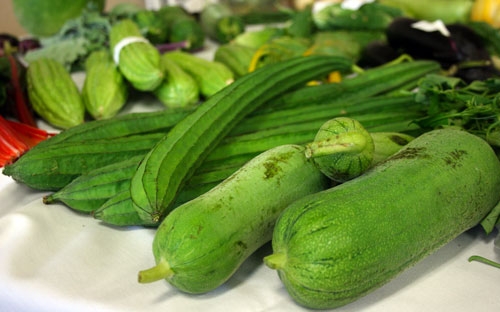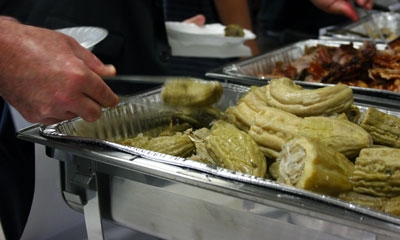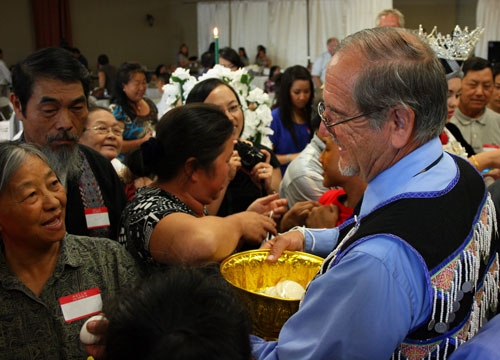Posts Tagged: UC Small Farm Program
Put down that zucchini! Pick up the ... bittermelon?

Welcome to August. Are you tired of summer squash yet?
If your dinners have been overflowing with zucchini recently (like mine have), now might be a great time to try new varieties of otherwise familiar vegetables.
One of the farm advisors I work with has long touted some varieties of "Asian vegetables" as more flavorful than their traditionally "American" cousins. Here in the U.S., vegetable varieties like these are more likely to be grown by farmers — and sold to customers — who have close ties to Asian immigrant communities. Richard Molinar, UC Cooperative Extension farm advisor for Fresno County, works frequently with Hmong farmers and says that he now prefers Hmong cucumber and Japanese eggplant to the varieties you might find in most California supermarkets.
After years of hearing Molinar's claims, I finally had a chance to try some of these new-to-me Asian vegetables during lunch at the Hmong Specialty Crops and Medicinal Herbs conference.
Presenters in the morning talked about crops such as sinqua, luffa (photo above has fresh luffa, in angled and smooth varieties), moqua, snake gourd, bittermelon and donqua — all of which are cucurbits, in the gourd family with other squashes and melons. Other Asian vegetables common in some specialty markets include leafy greens and tender shoots from chayote, amaranth, bittermelon, pumpkin, okra leaf, yam leaf, yucca and sour leaf plants. Discussions at the conference focused on these and other specialty crops, including ways to eat them.
"Maybe we need a recipe to teach customers how to buy these new crops," said Chukuo Thao, CEO of National Hmong American Farmers, who alternated between English and Hmong while speaking at the conference.

Some of the vegetables and herbs discussed at the conference were highlights of that day's lunch. The menu included a slushy Hmong cucumber drink, purple sticky rice, salsa made with cherry tomatoes, stir-fried mustard greens with pork skin, Hmong herbal chicken soup and steamed bittermelon stuffed with turkey.
But how did it taste? The stuffed bittermelon was what I was most looking forward to trying. The dish was delicious and wow, was it bitter! That is one appropriately named vegetable. Speakers at the conference suggested bitterness is frequently associated with medicinal qualities in Hmong cuisine.
Not all of the lunch dishes were bitter, of course. The cucumber dish was refreshing and very sweet, a dish with eggplant was spicy, and the mustard greens were salty and pungent. Many of the dishes were also made with lemongrass; Fresno County is where most of the nation's lemongrass comes from, according to Molinar in a recent article from the California Ag Network.
Curious about other Asian vegetables? Check out the Small Farm Program's guides to Asian vegetables, along with tips for farmers about how to grow and sell these niche varieties.
Question: The Small Farm Program has a lot of information about different vegetable varieties, but I'm still finding new vegetables to try. What are some of your favorite Asian vegetables?
P.S. While the conference was my first chance to taste bittermelon, Richard Molinar and Gus Schumacher (former USDA undersecretary) were being honored by Hmong community members for their long-time support of Southeast Asian refugee farmers. The two men were each given Hmong names in a special ceremony.

Looking for a farm or ranch experience?
This weekend, you're in luck. You can bring your favorite children to Kids Day on the Farm in San Luis Obispo County to churn butter, plant sunflowers, press cider, make a cornhusk doll and lots more. You can learn draft horse driving, go on a calf feeding tour, and enjoy bluegrass music at the Heartland Festival in Merced County, take a bus tour from Berkeley to pick peaches at Frog Hollow Farm in Brentwood, shop for apple butter at the Gravenstein Apple Fair in Sebastopol, or hike to the top of the hill to see great views of San Francisco Bay on a Petaluma organic farm.
or you can use the calendar to find special events. The website is getting more popular every week since we worked with the ANR communications team to add the calendar and the UC Food Blog to keep it looking fresh for visitors searching for adventure and education.
If you are a working farmer or rancher operating an agritourism business or organizing agritourism events, we invite you to complete the directory application or the event listing application online so we can include your business and events in the directory. The listings and event postings are always free. You can also include a picture with your event posting.
With more than eighty-five percent of Californians living in cities of at least one million people, most of us don't know the people who grow and raise our food, and most of us don't get many chances to visit farms or ranches. A growing number of farmers and ranchers are opening their land to visitors by starting enterprises that offer urban and suburban people a chance to experience agricultural life.
These agritourism operations serve the triple purposes of bringing additional revenue to the growers, building connections between urban and rural communities, and giving the producers the chance to sell farm products directly to the public right at the farm. An apple pie bought straight from the apple ranch pie shop will just taste better than one bought in town!
Agritourism is a growing business in California. Farmers and ranchers who would like more information about starting agritourism enterprises may be interested in the agritourism section of the Small Farm Program website, and may want to subscribe to the AgTour Connections newsletter.
Have a great weekend out of town!


Bellydancing with your blueberries?
How about looking at Saturn through a telescope, picking your own cherries and blueberries, learning from UC Merced scientists how they estimate snow pack and water flow, taking a dip in the river, tasting local olive oil, wine and cheese, painting a picture, petting a lamb, and camping out in the walnut orchard? About 600 people enjoyed all this and more at the Pick and Gather Festival at Riverdance Farm in Merced County June 5 and 6.

Organic farmers Cindy Lashbrook and Bill Thomson, owners of the 70-acre diversified Riverdance Farm, host this annual event the weekend after Memorial Day. Lashbrook and Thomson are among the growing number of small and mid-scale California farmers and ranchers who open their farm gates to the public for enjoyment and education, helping to build community and connection between the 98 percent of Californians who do not work in agriculture and the 2 percent who do.
The Pick and Gather this year was a mellow family-friendly event with bands, folk-singers and belly-dancers entertaining the crowd. Informational booths, staffed by the UC Cooperative Extension Master Gardeners, the WIC program, Valley Land Alliance, the Merced Farm Bureau and other local groups, were very popular. Local farms offered honey, jams, lemonade, olive oil and other goodies in a shady general store, and there was plenty of room to sit and enjoy lunch prepared by vendors or to eat picnics brought from home. Delicious ripe U-pick organic cherries and blueberries were at wholesale prices. With unemployment in Merced County at about 20 percent this year, Lashbrook and Thomson keep the admission price low and make sure to offer lots of free children’s activities, including art and a petting zoo, and of course, the river to play in.
Riverdance Farm itself, like many farms its size, is having a difficult time staying in business by simply selling crops.The owners would like to see their festival be part of helping sustain the farm financially without losing its friendly community feeling. Most of the visitors were not aware of the costs involved in putting on a festival, from the insurance to the health permit fees to the renting of the water-truck and the porta-potties, not to mention the cost of the farmers’ time away from the work of farming. Lashbrook estimates that it would take another few hundred visitors and maybe some more sponsors and paying vendors to turn the Pick and Gather into an income-generating venture.
The UC Small Farm Program’s agritourism project works to help agritourism operators plan successful and profitable agritourism enterprises on their working farms and ranches, and also to help visitors find festivals and other agritourism activities on working farms and ranches. The Small Farm Program website has a wealth of resources for growers evaluating their own potential for agritourism operations and navigating the risk management, business planning, permitting and promotional aspects of the new businesses.
Agritourism is blossoming in California, with farm tours, classes, farm stays, U-pick operations, farm stands and festivals in almost every county. Potential visitors can find a farm or ranch to visit and check the calendar for events at www.calagtour.org, the University of California’s agritourism directory. Farmers and ranchers are invited to list their agritourism operations and events on the site for no charge.

Riverdance general store

Valley Land Alliance booth

A dip in the Merced River

Blueberry pickers